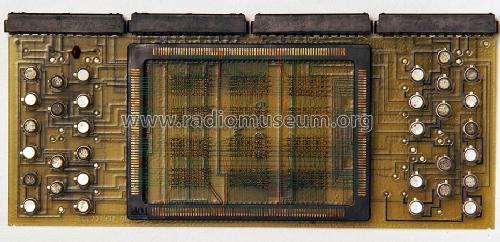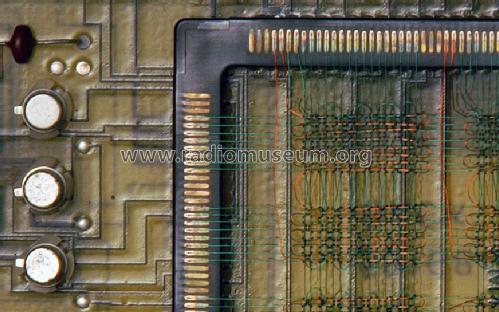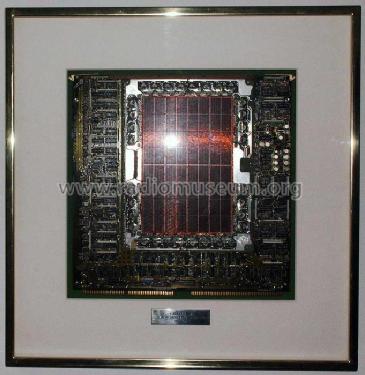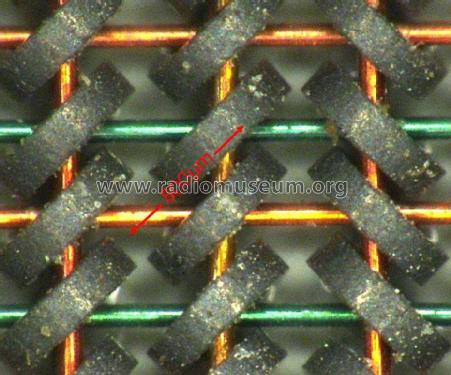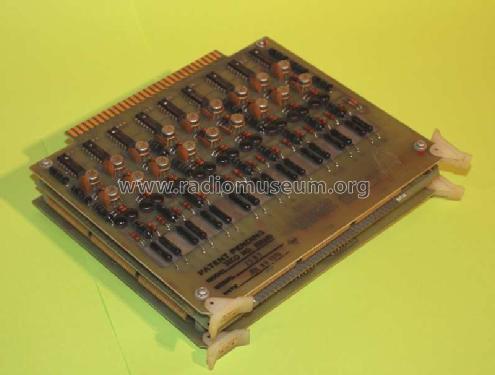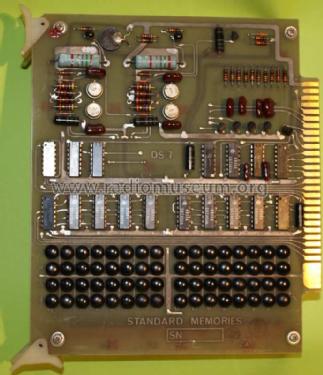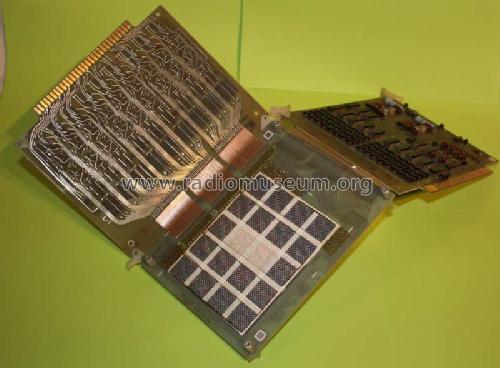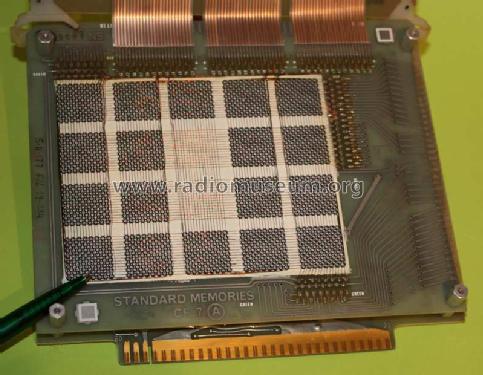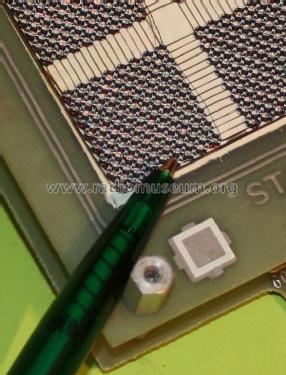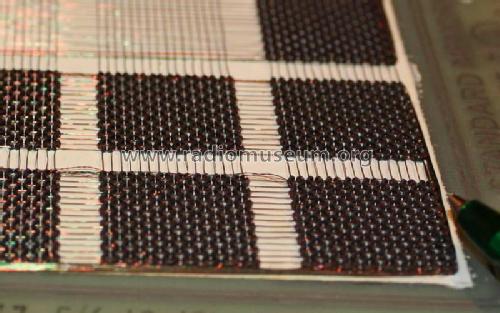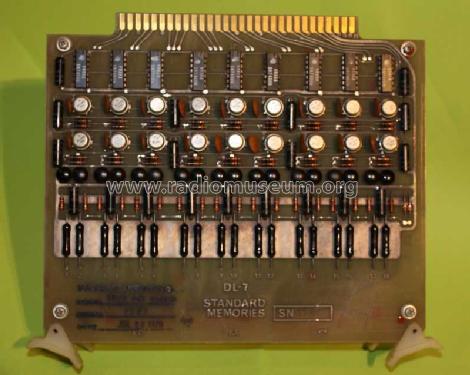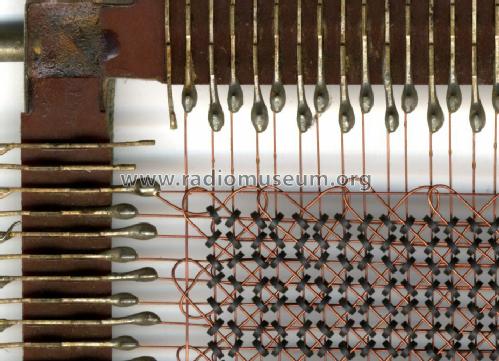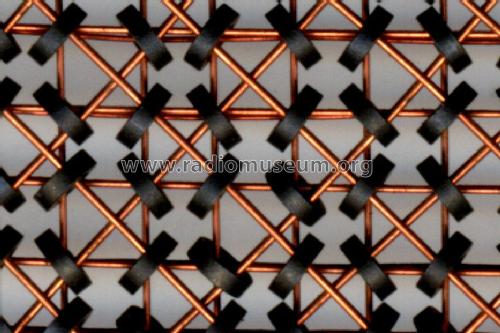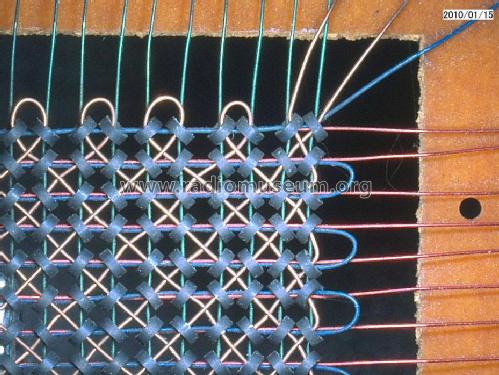Ferrite Core Memory
Unknown to us - Worldwide
- Pays
- Worldwide
- Fabricant / Marque
- Unknown to us - Worldwide
- Année
- 1950–1965
- Catégorie
- Divers / autres - détails dans les remarques
- Radiomuseum.org ID
- 159567
- Gammes d'ondes
- - sans
- Tension / type courant
- Alimentation externe ou alimentation principale
- Matière
- Matériaux divers
- De Radiomuseum.org
- Modèle: Ferrite Core Memory - Unknown to us - Worldwide
- Forme
- Chassis (pour intégration dans meuble)
- Remarques
- This model page is only to show as an example "Ferrite Core Memory" the development of such memories from using tubes as coordinate drivers and later transistors. You are invited to upload pictures - but please describe in the legend what you show by naming - if possible - manuafacturer, date of manufacturing, size, memory size and may be types of tubes or transistors involved - and purpose (where was it built in). Everything you know. You acn also start a forum article from this model page - but please do not introduce more model pages for this.
Diese Modellseite dient für das Hochladen von Bildern von Kernspeichern, wobei sie bitte alle Angaben in die Bildlegende schreiben, die Sie geben können, wie Hersteller, Datum, wo verwendet, Masse, Röhren- oder Trnasistoren als "Koordinaten Treiber" etc. Sie können auch Beiträge starten, doch sollten Sie keine neue Modellseite für Kernspeicher anlegen.
- Auteur
- Modèle crée par Ernst Erb. Voir les propositions de modification pour les contributeurs supplémentaires.
- D'autres Modèles
-
Vous pourrez trouver sous ce lien 834 modèles d'appareils, 767 avec des images et 29 avec des schémas.
Tous les appareils de Unknown to us - Worldwide
Collections
Le modèle Ferrite Core Memory fait partie des collections des membres suivants.
Contributions du forum pour ce modèle: Unknown to us -: Ferrite Core Memory
Discussions: 1 | Publications: 10
A guest from Australia, David Edwards, Rhodes NSW2138, sent me a picture from an old ferrite core memory, a printed circuit board (PCB), which contains 384 bits (48 bytes) of memory. It is made in Germany around 1964 and uses the transistor AC132 from Valvo:
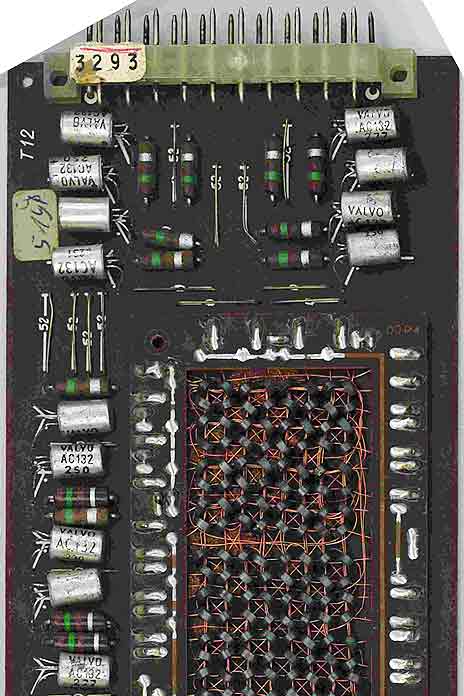
This is only a part of it to fit as integrated picture. See attachment.
What did I have to do with computers?
Guests which enter my home find a picture of a core memory board on the wall of the entrance hall. It is from my first computer which I could buy in 1972: a used IBM model 360-30, the first byte computer model (market introduction 1964). The memory was given to me for 20 years of "Data Center Luzern AG" by my staff in 1983. We got rid of the "old system" at that time, which served us so well. The rent of the system would have cost me 60 000 Swissfranks per month, so I have chosen to buy a used system - and found it in Philadelphia, USA. It was a hard job to insist that IBM Switzerland had to agree with a service contract or service it at all ...
Before we did use computers (like IBM 1401) from big companies at night by minute price which summed up to 25 000 Swissfranks a month. The memory board of IBM 360 has 16 KB and the machine had 4 of those boards. I tell this story just to show the difference to today. We needed a big, air-conditioned room and the system had a tiny fraction of "calculating power" compared with a todays netbook ...
I also tell this story because it was for one part "my own way" to handle things - 9 years hard work at night, then an outdated machine which even heated our business house I built in 1978 - and on the other hand the splendid staff (personnel) and the "old computer" which gave me the possibility to now finance Radiomuseum.org. I wondered then that the idea for using a computer as the only heating source seemed having been new ... We just filled two tanks with the warm water, the air-conditioning plant produced. Each tank does (still) hold 20 tons which only had to be distributed in the central heating which was in the ceilings. The building is well insulated and we could even de-ice a slope for cars outside the building.
Before I worked 5 years for IBM where I could save the money to start my own business. There I was first confronted with ferrite core memory. Before, in London, I was confronted with a tube computer at C.T. Bowring & Co. See the last link and open the documents from Christian Adam.
Some history about Ferrite Core Memory (Storage)
I don't know if the first ferrite core memory is based on US patent 2,667,542 (Electric Connecting Device) from Esmond Philip Goodwin Wright, London, England, assignor to ISE New York with priority GB September 26, 1950. It was filed Sept. 25, 1951 in the US. But Wright used only two wires - mainly for transferring communication currents by static coupling ... to co-ordinate switches for telecommunication switching systems.
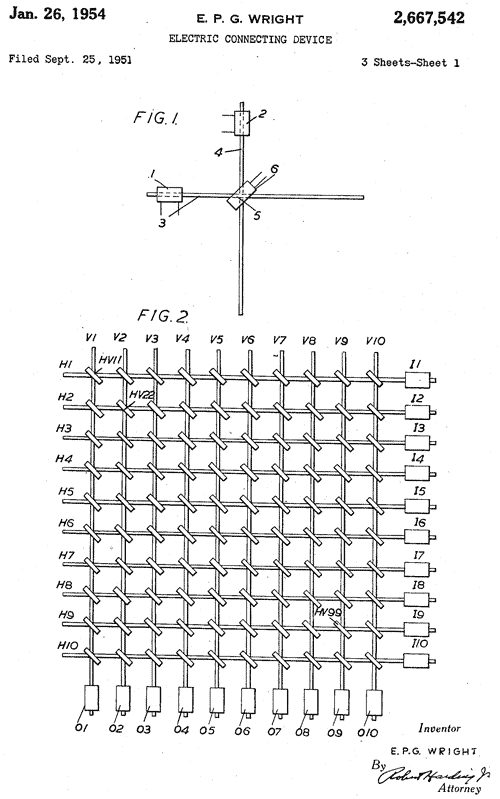
At least this started quite some work around this possibility to get rid of the Flip-Flop-Tube storages for the Central Processing Memory (CPU) with its ALU (Arithmetic Logic Unit, 1946 Neumann fro Princeton Institute of Advanced Studies (IAS) or later FPU (Floating Point Unit). This had to allow a non-cyclic or "random access", preferably keeping the memory when switched off. Before the ferrite core memory this had to be achieved either mechanically, by relais or by tubes entirely. Also magnetic drum storage devices and others were used partly for the "central memory" which stored certain programs, registers, variables, calculations, etc. but this could be a cyclic type.
Cyclic memories have to go through a complete cycle before a given element of information is available for reading, rewriting or alteration. There were used sonic or electromagnetic delay lines, magnetic drums and tapes, punched tapes and some forms of electrostatic storage tubes. Random Access Memories allow writing and reading within any part of the memory at any time. Before the ferrite core memory, banks of electromagnetic or electronic relays often made with cathode ray tubes (Williams-Kilburn tube) or "selectron" tubes were used.
Frederick W. Viehe (1947) and An Wang (1949) began independently experimenting with cores for computer memories - at about the same time vacuum tubes were replacing electromechanical calculators. Later development work was done by others, including the MIT, RCA and IBM. Jay Wright Forrester, working in MIT for the project Whirlwind, was perfecting the core memory and filed a patent May 11, 1951 which was patented Feb. 28, 1956 as 2'736'880. (Cited patents: 1504882, 2053156, 2430457, 2518022, 2519513, 2524154, 2574438 and 2696600).
The MIT memory is a matrix of magentic cores, supported by cross grids of wires, to which two pulses at the same time of electric current are applied to "address wires", one for a given column, the other for a given row. Selectors, first realized with tubes, drive the selection process. They are arranged at the outside of the actual matrix. This allowes to imply which core is addressed and at the same time feeds enough power to create a change - if the magnetic field is reverse. The third wire is the "sense wire" (or output wire) which detects changes of the magnetic field. It is an inhibit wire for each plane which threads all the cores in the plane. In the event of reading, two half cycles are used, one to detect a change (or not) and the second to re change again to the value before. To store or write one half cycle is enough. Each core represents a binary value of either 1 or Zero.
Just an example of such patents:
Milton Rosenberg (plus Modlinski, Oaks, Alexander, Palisades and Minka, assignors to Telemeter Magnetics, Inc.) filed March 28, 1955 a patent for a "Magnetic-Switch Cross-Coupling Minimization System". It was patented October 13, 1959 as 2,908,893. "Switching is achieved by selectively driving certain ones of a plurality of magnetic cores from saturation at one polarity to saturation at the opposite polarity by the use of vacuum tubes." They state: "Magnetic memories of the type employing arrays of magnetic cores having substantially rectangular hysteresis characteristics are presently finding favor as the memory components in information-handling machines. Such a memory is described in the article entitled "The M.I.T. Magnetic-Core Memory", by William N. Papian, published in the Proceedings of the Eastern Joint Computer Conference, Washington D.C, December 1953 (pages 37-42) ... In an article in the RCA Review, entitled "Static Magnetic Matrix Memory and Switching Circuits", by Jan A. Rajchman, volume 13, pp. 183-201, June 1952 issue, there is described a magnetic switch which may be employed to reduce the number of tubes required for driving the magnetic memory."
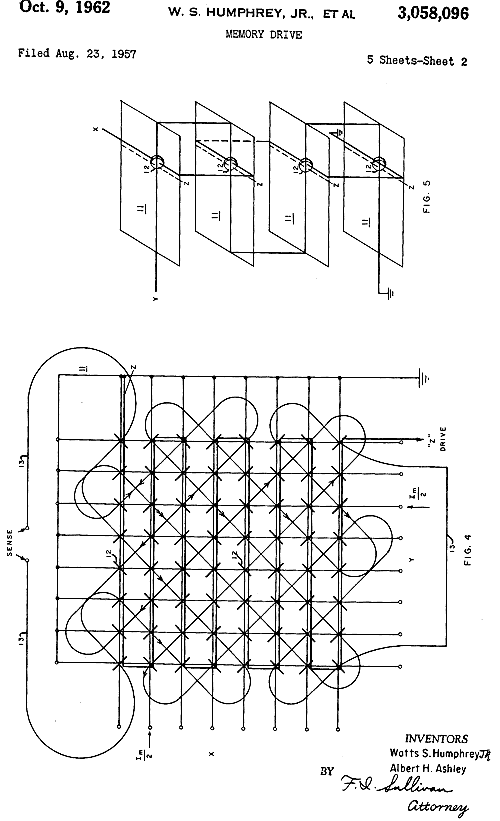
What we know is that IBM claims that it has used its flagship, the IBM 405 Alphabetical Accounting Machine (also called tabulator) from 1934 to build in an experimental core memory in 1952 - despite the fact that the machine was not sold anymore after May 1949 - except reconditioned machines (ibm.com). The system was tested in April 1952.
IBM used it then to replace the storage-tube memory in the IBM 701 Defensive Calculator, IBM's first commercial scientific computer and at the same time first large-scale computer and first IBM machine with programs stored in an internal adressable electronic memory. The storage were 72 Williams tubes with a capacity fo 1024 bytes each. The memory cycle time for both, Williams tube or later magnetic core was 12 microseconds. First appereance on market April 7, 1953. 19 systems sold.
In the early 1950ies there were quite some articles about ferrite core memories like J.W. Forrester in an article entitled "Digital Information Storage in Three Dimensions Using Magnetic Cores" in the Journal of Applied Physics volume 22, page 44 of January 1951. Or David R. Brown and Ernest Albers-Schoenberg with "Ferrites Speed Digital Computers" in "Electronics" page 146 of April 1953, published by the McGraw-Hill Publishing Company. Or N. Pappian in an article on page 194 of the same Journal, March 1955 for a ferrite core memory using pulse transformers, arranged in separate planes, with each plane having for example 64 horizontal and 64 vertical rows of cores, resulting in a total of 4096 cores per plane.
Many patents then dealt with the high number of vacuum tubes required as coordinate drivers (3,058,096 Watts S. Humphrey, Cochituate and Albert H. Ashley for Sylvania Electric Products Inc., filed Aug. 23, 1957), the speed, the problem of disturbances (Bauer 2,889,540, filed July 14, 1954 - with tubes like for Russell in 2,929,050, filed May 27, 1955) etc. and the techniques for being able to get away from the hand made process and later to solid state technique and to printed circuits like the one above. The first patent about ferrite core memory on printed circuit is probably Paul V. Horton for IBM, filed May 10, 1955, patented Jan 31, 1961 as 2,970,296.
Just to show a fraction of patents I list here the cited patents in the 2,970,296. It is listed by patent date, not filing date which can be even years earlier:
1,988,734 Helgason, Jan. 22, 1935
2,588,726 Hoover, Mar. 11, 1952
2,603,681 Salisbury, July 15, 1952
2,654,142 Horelick, Oct. 6, 1953
2,700,150 Wales, Jan. 18, 1955
2,712,126 Rosenberg et al. June 28, 1955
2,719,965 Person, Oct. 4, 1955
2,724,103 Ashenhurst, Nov. 15, 1955
2,732,542 Minnick, Jan. 24, 1956
2,734,150 Beck, Feb. 7, 1956
2,757,443 Steigerwalt et al., Aug. 7, 1956
2,762,113 Daniels et al., Sept. 11, 1956
2,774,014 Henry, Dec. 11, 1956
2,784,391 Rajchman, Mar. 5, 1957 (see also Rajchman 2,691,154)
2,792,563 Rajchman, May 14, 1957
2,823,371 Jones, Feb. 11, 1958
2,870,433 Simpson, Jan. 20, 1959
Roughly about 10 years before the appeareance of IBM 360-30 or the board above with the AC132, transistors were used. In the IBM 1401 from October 1959 they have been packed into common housings for a half a dozen transistors in the same case and for the IBM 360 brought more integration with Solid Logic Technology (SLT) but VLSI with thousands of transistor-based circuits began in the 1970s when complex semiconductor and communication technologies were being developed. The microprocessor is an example but now it integrates hundred of millions of transistors.
A model page for Ferrite Core Memories
To be able to show early and later examples of Ferrite Core Memories I have introduced a model page to Radiomuseum.org. Please use the link above the text. I have none of such Magnetic Core Memories with tubes and hope somebody has and can upload photos - or finds images in the literature. Anyway it is clear that tubes were involved at the start which gives us the reason to introduce also Ferrite Core Memories - but we will not create more model pages but use this one for presenting more articles and/or pictures. We can remember: The development of transistors (Translation from Vincent de Franco) and of the ferrite core memory was about at the same time.
Ernst Erb, 07.Aug.09

